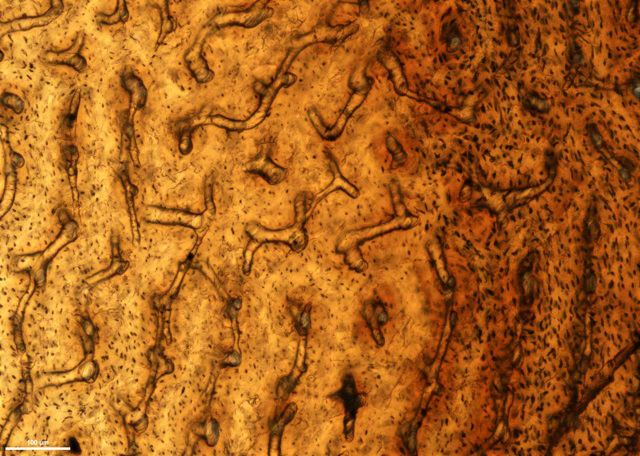
This thin section of a shinbone belonged to a dinosaur who lived 70 million years ago. The growth marks depicted here are like tree rings, revealing the age of the specimen. Photo credit: Greg Funston
A 70-million year-old shin bone is providing insight into dinosaur development and new ways of distinguishing different species, according to a new study by University of Alberta paleontologists.
The specimen, found near Drumheller, Alberta, is from a less-understood group of dinosaurs called caenagnathids. Paleontologists examined a cross-section of the animal's tibia, or shinbone.
"The shape of the cross-section seems to be consistently different between different families," explained Greg Funston, PhD candidate, Vanier scholar, and lead author on the study. "There is also a difference in the relationship between this bone and another bone, the fibula. Using these two features, we show that you can distinguish between most of the theropods we find in Alberta."
Digging into development
The results of this study also provide valuable insight into how this particular species developed. Like trees, dinosaur bones show lines of arrested growth (LAGs) each year, allowing the scientists to determine the specimen's age and pattern of development.
"The bone on the inside, from when the animal was younger, is more slow-growing than the bone on the outside, which shows us that the animal was increasing its growth rate at this particular point in its life," said Funston. "The transition is close to, but just before the first birthday."
Understanding how dinosaurs grew gives important insight into how the creatures not only reached massive proportions but also miniaturized into birds.
"We can also learn how their growth styles changed over time in response to environmental change, the introduction of new species, and extinction events," explained Funston. "This may help us understand the changes going on around us right now as species go extinct in reaction to climate change."
The paper, "A small caenagnathid tibia from the Horseshoe Canyon Formation (Maastrichtian): Implications for growth and lifestyle in oviraptorosaurs," was published in Cretaceous Research (doi: 10.1016/j.cretres.2018.08.020).